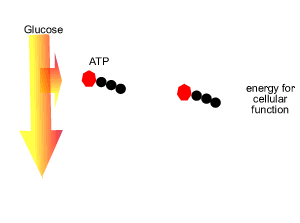Energy is stored in many ways in the cells of organisms. However the energy currency for useable energy in a cell is adenosine triphosphate (ATP). ATP is like a rechargeable biological battery, which releases small packets of energy for the cell.
The energy stored in the chemical bonds of glucose, fats and proteins, to a lesser extent, is used to create highly energetic chemical bonds between the phosphates in ATP. This is known as cellular respiration.
Consider the animation on the right. It shows the breakdown of glucose to release the energy needed to form a highly energetic bond between adenosine diphosphate and a phosphate molecule. The ATP formed is used by the cell for energy. As the terminal phosphate breaks off the ATP energy is released. Usually only one phosphate is removed to provide energy and the products are recycled. The animation on the right summarises the reaction below.
ATP => ADP + Pi + Energy
ADP + Pi + Energy => ATP

But how do we harvest the energy from food such as glucose?
Continue